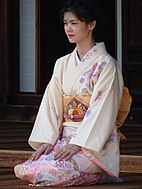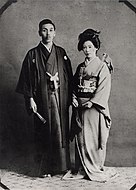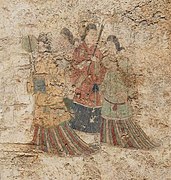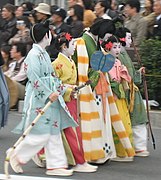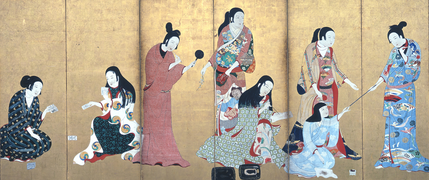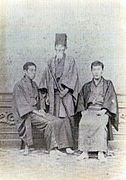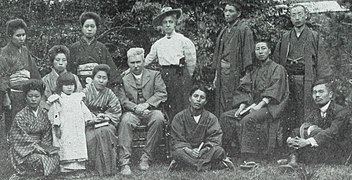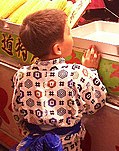
A | B | C | D | E | F | G | H | CH | I | J | K | L | M | N | O | P | Q | R | S | T | U | V | W | X | Y | Z | 0 | 1 | 2 | 3 | 4 | 5 | 6 | 7 | 8 | 9


| Kimono | |||||
|---|---|---|---|---|---|
'Kimono' in kanji | |||||
| Japanese name | |||||
| Kanji | 着物 | ||||
| |||||
The kimono (きもの/着物, lit. 'thing to wear')[a] is a traditional Japanese garment and the national dress of Japan. The kimono is a wrapped-front garment with square sleeves and a rectangular body, and is worn left side wrapped over right, unless the wearer is deceased.[2] The kimono is traditionally worn with a broad sash, called an obi, and is commonly worn with accessories such as zōri sandals and tabi socks.
Kimono have a set method of construction and are typically made from a long, narrow bolt of cloth known as a tanmono, though Western-style fabric bolts are also sometimes used.[3] There are different types of kimono for men, women, and children, varying based on the occasion, the season, the wearer's age, and – less commonly in the modern day – the wearer's marital status. Despite the kimono's reputation as a formal and difficult-to-wear garment, there are types of kimono suitable for both formal and informal occasions. The way a person wears their kimono is known as kitsuke (着付け, lit. 'dressing').
The history of the kimono can be tracked back to the Heian period (794–1185), when Japan's nobility embraced a distinctive style of clothing. Formerly the most common Japanese garment, the kimono has fallen out of favor and is rarely worn as everyday dress now. They are most often seen at summer festivals, where people frequently wear the yukata, the most informal type of kimono. More formal types are worn to funerals, weddings, graduations, and other formal events. Geisha and maiko are required to wear a kimono as part of their profession, and rikishi (sumo wrestlers) must wear kimonos at all times in public.[4] Despite the small number of people who wear it regularly and its reputation as a complicated garment, the kimono has experienced a number of revivals in previous decades, and is still worn today as fashionable clothing in Japan.
History
This section needs additional citations for verification. (August 2020) |
-
Women's dress under Goguryeo influence, with overlapping collar and mo skirt.[5] (Takamatsuzuka Tomb, 7th century)
-
Asuka (late Yamato Period) dress, 7th century
-
Nara-period dress, late 8th century, 2005 reconstruction
Yamato period to Nara period (300–794)
The first instances of kimono-like garments in Japan were traditional Chinese clothing introduced to Japan via Chinese envoys in the Kofun period (300–538 CE; the first part of the Yamato period), through immigration between the two countries and envoys to the Tang dynasty court leading to Chinese styles of dress, appearance, and culture becoming extremely popular in Japanese court society.[1] The Imperial Japanese court quickly adopted Chinese styles of dress and clothing,[6] with evidence of the oldest samples of shibori tie-dyed fabric stored at the Shōsōin Temple being of Chinese origin, due to the limitations of Japan's ability to produce the fabrics at the time.[7] As early as the 4th century CE, images of priestess-queens and tribal chiefs in Japan depicted figures wearing clothing similar that of Han dynasty China.[8]
In 718 CE, the Yoro clothing code was instituted, which stipulated that all robes had to be overlapped at the front with a left-to-right closure, following typical Chinese fashions.[9]: 133–136 This convention of wear is still followed today, with a right-to-left closure worn only by the deceased.[9]
Clothing used by the upper classes was significantly simpler to don and wear than dress from the following Heian period.[10] Sleeves, while narrow, were long enough to cover the fingers, since status was associated with covering more of the body.[11][10]
Heian period to Azuchi–Momoyama period (794–1600)
During the Heian period (794–1193 CE), Japan stopped sending envoys to the Chinese dynastic courts. This prevented Chinese-imported goods—including clothing—from entering the Imperial Palace. This also prevented dissemination to the upper classes, who were the main arbiters of traditional Japanese culture at the time, and the only people allowed to wear such clothing.[12] The ensuing cultural vacuum facilitated the development of a Japanese culture independent from Chinese fashions. Elements previously lifted from the Tang Dynastic courts developed independently into what is known literally as "national culture" or "kokufū culture" (国風文化, kokufū-bunka). The term is used to refer to Heian-period Japanese culture, particularly that of the upper classes.[13]
Women's clothing in the imperial palace became increasingly stylized in the formal jūnihitoe, with some elements being abandoned by both male and female courtiers, such as the round-necked and tube-sleeved chun ju jacket worn by both genders in the early 7th century. Others, such as the wrapped front robes also worn by men and women, were kept. Some elements, such as the mo skirt worn by women, continued to in a reduced capacity, worn only to formal occasions;[1] the mо̄ (裳) grew too narrow to wrap all the way around and became a trapezoidal pleated train.[14] Hakama (trousers) became longer than the legs and also trailed behind the wearer.[15]
During the later Heian period, various clothing edicts reduced the number of layers a woman could wear, leading to the kosode (lit. 'small sleeve') garment—previously considered underwear—becoming outerwear by the time of the Muromachi period (1336–1573 CE). Originally worn with hakama, the kosode began to be held closed with a small belt known as an obi instead.[1] The kosode resembled a modern kimono, though at this time the sleeves were sewn shut at the back and were smaller in width (shoulder seam to cuff) than the body of the garment. During the Sengoku period (1467–1615) and the Azuchi–Momoyama period (1568–1600), the decoration of the kosode developed further, with bolder designs and flashy colours becoming popular. By this time, separate lower-body garments, such as the mō and hakama, were almost never worn,[15] allowing full-length patterns to be seen.
-
In the late Heian period, the jūnihitoe consisted of many layers (hitoe) worn over a plain kosode and hakama.[16] (The Tale of Genji, 12th century)
-
The courtiers in the foreground are wearing their hitoe off-the-shoulder, showing the kosode beneath.
-
The kosode worn as outerwear. Note wider cut of the body, unisex narrow obi and shorter sleeves. Matsuura byōbu, c. 1650, Azuchi-Momoyama period.
Edo period (1603–1867)

During the Edo period (1603–1867 CE), both Japan's culture and economy developed significantly. A particular factor in the development of the Edo period was the early Genroku period (1688–1704 CE), wherein "Genroku culture" – luxurious displays of wealth and increased patronage of the arts – led to the further development of many art forms, including those of clothing. Genroku culture was led by the growing and increasingly-powerful merchant classes (chōnin), whose clothing was representative of their increasing economic power and rivaled the aristocracy and samurai classes, shown by their brightly-coloured kimono that utilised expensive production techniques, such as hand-painted dyework.[17] Rinzu, a damask fabric, also became the preferred material for kimono at this time, replacing the previously-popular nerinuki plain-weave silk, which had been used to create tsujigahana.[18]
In response to the increasing material wealth of the merchant classes, the Tokugawa shogunate issued a number of sumptuary laws on kimono for the lower classes, prohibiting the use of purple or red fabric, gold embroidery, and the use of intricately dyed shibori patterns.[19] As a result, a school of aesthetic thought known as Iki developed. They valued and prioritised the display of wealth through an almost mundane appearance, and the concept of kimono design and wear continues to this day as a major influence.
From this point onwards, the basic shape of both men's and women's kimono remained largely unchanged.[1] The sleeves of the kosode began to grow in length, especially amongst unmarried women, and the obi became much longer and wider, with various styles of knots coming into fashion, alongside stiffer weaves of material to support them.[1]
In the Edo period, the kimono market was divided into craftspeople, who made the tanmono and accessories, tonya, or wholesalers, and retailers.[20]: 129
Modern period
Meiji period (1868–1912)
-
Part of the Ootuki family in kimono, 1874
-
Assorted types of kimono, Western dress, a court lady in keiko, and a schoolgirl in a high-collared shirt, kimono and hakama. All wear both purple and red. 1890.
-
Family of Horiai Setsuko, May 1912, some in European dress, some in kimono, some wearing hakama. Women's hakama spread from the court as part of Japanese reform dress.
In 1869, the social class system was abolished, and with them, class-specific sumptuary laws.[20]: 113 Kimono with formerly-restricted elements, like red and purple colours, became popular,[20]: 147 particularly with the advent of synthetic dyestuffs such as mauvine.
Following the opening of Japan's borders in the early Meiji period to Western trade, a number of materials and techniques – such as wool and the use of synthetic dyestuffs – became popular, with casual wool kimono being relatively common in pre-1960s Japan; the use of safflower dye (beni) for silk linings fabrics (known as momi; literally, "red silk") was also common in pre-1960s Japan, making kimono from this era easily identifiable.
During the Meiji period, the opening of Japan to Western trade after the enclosure of the Edo period led to a drive towards Western dress as a sign of "modernity". After an edict by Emperor Meiji,[citation needed] policemen, railroad workers and teachers moved to wearing Western clothing within their job roles, with the adoption of Western clothing by men in Japan happening at a much greater pace than by women. Initiatives such as the Tokyo Women's & Children's Wear Manufacturers' Association (東京婦人子供服組合) promoted Western dress as everyday clothing.
Taishō period (1912–1926)
Western clothing quickly became standard issue as army uniform for men[21] and school uniform for boys, and between 1920 and 1930, the fuku sailor outfit replaced the kimono and undivided hakama as school uniform for girls.[1]: 140 However, kimono still remained popular as an item of everyday fashion; following the Great Kantō Earthquake of 1923, cheap, informal and ready-to-wear meisen kimono, woven from raw and waste silk threads unsuitable for other uses, became highly popular, following the loss of many people's possessions.[22] By 1930, ready-to-wear meisen kimono had become highly popular for their bright, seasonally changing designs, many of which took inspiration from the Art Deco movement. Meisen kimono were usually dyed using the ikat (kasuri) technique of dyeing, where either warp or both warp and weft threads (known as heiyō-gasuri)[22]: 85 were dyed using a stencil pattern before weaving.
It was during the Taishō period that the modern formalisation of kimono and kimono types began to emerge. The Meiji period had seen the slow introduction of kimono types that mediated between the informal and the most formal, a trend that continued throughout the Taishō period, as social occasions and opportunities for leisure increased under the abolition of class distinctions. As Western clothing increased in popularity for men as everyday clothing, the kimono industry further established its own traditions of formal and informal dress for women; this saw the invention of the hōmongi, divisions of tomesode (short-sleeved) kimono for women, and montsuki hakama.[20]: 133-134 The bridal kimono trousseau (oyomeiri dōgu), an uncommon practice of the upper classes in the Edo period, also became common throughout the middle classes;[20]: 67, 76 traditions of kimono bridalwear for marriage ceremonies were also codified in this time, which resembled the bridalwear of samurai-class women.[20]: 82, 93, 146 Standards of kitsuke at this time began to slowly graduate to a more formalised, neatened appearance, with a flat, uniform ohashori and a smooth, uncreased obi, which also resembled the "proper" kitsuke of upper-class women. However, kitsuke standards were still relatively informal, and would not become formalised until after World War II.
Shōwa period (1926–1989)
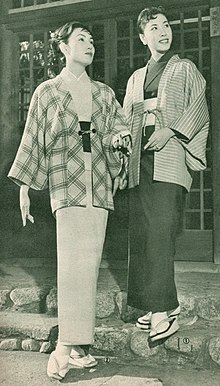
While kimono were no longer common wear for men, they remained everyday wear for Japanese women until World War II (1940–1945).[20]: 17 Though the Taishō period had seen a number of invented traditions, standards of kitsuke (wearing kimono) were still not as formalised in this time, with creases, uneven ohashori and crooked obi still deemed acceptable.[20]: 44-45
During the war, kimono factories shut down, and the government encouraged people to wear monpe (also romanised as mompe) – trousers constructed from old kimono – instead.[20]: 131 Fibres such as rayon became widespread during WWII, being inexpensive to produce and cheap to buy, and typically featured printed designs.[citation needed] Cloth rationing persisted until 1951, so most kimono were made at home from repurposed fabrics.[20]: 131
In the second half of the 20th century, the Japanese economy boomed,[20]: 36 and silk became cheaper,[citation needed] making it possible for the average family to afford silk kimono.[20]: 76 The kimono retail industry had developed an elaborate codification of rules for kimono-wearing, with types of kimono, levels of formality, and rules on seasonality, which intensified after the war; there had previously been rules about kimono-wearing, but these were not rigidly codified and varied by region and class.[20]: 36 Formalisation sought perfection, with no creases or unevenness in the kimono, and an increasingly tubular figure was promoted as the ideal for women in kimono.[20]: 44-45 The kimono-retail industry also promoted a sharp distinction between Japanese and Western clothes;[20]: 54 for instance, wearing Western shoes with Japanese clothing (while common in the Taishō period) was codified as improper;[20]: 16 these rules on proper dressing are often described in Japanese using the English phrase "Time, Place, and Occasion" (TPO). As neither Japanese men or women commonly wore kimono, having grown up under wartime auspices, commercial kitsuke schools were set up to teach women how to don kimono.[20]: 44 Men in this period rarely wore kimono, and menswear thus escaped most of the formalisation.[20]: 36, 133 ).
Kimono were promoted as essential for ceremonial occasions;[20]: 76, 135 for instance, the expensive furisode worn by young women for Seijinshiki was deemed a necessity.[20]: 60 Bridal trousseaus containing tens of kimono of every possible subtype were also promoted as de rigueur, and parents felt obliged to provide[20]: 76 kimono trousseaus that cost up to 10 million yen (~£70,000),[20]: 262 which were displayed and inspected publicly as part of the wedding, including being transported in transparent trucks.[20]: 81
By the 1970s, formal kimono formed the vast majority of kimono sales.[20]: 132 Kimono retailers, due to the pricing structure of brand new kimono, had developed a relative monopoly on not only prices but also a perception of kimono knowledge, allowing them to dictate prices and heavily promote more formal (and expensive) purchases, as selling a single formal kimono could support the seller comfortably for three months. The kimono industry peaked in 1975, with total sales of 2.8 trillion yen (~£18 billion). The sale of informal brand new kimono was largely neglected.[20]: 135, 136
Heisei period (1989–2019)
The economic collapse of the 1990s bankrupted much of the kimono industry[20]: 129 and ended a number of expensive practices.[20]: 98 The rules for how to wear kimono lost their previous hold over the entire industry,[20]: 36 and formerly-expensive traditions such as bridal kimono trousseaus generally disappeared, and when still given, were much less extensive.[20]: 98 It was during this time that it became acceptable and even preferred for women to wear Western dress to ceremonial occasions like weddings and funerals.[20]: 95, 263 Many women had dozens or even hundreds of kimono, mostly unworn, in their homes; a secondhand kimono, even if unworn, would sell for about 500 yen (less than £3.50;[20]: 98 about US$5), a few percent of the bought-new price. In the 1990s and early 2000s, many secondhand kimono shops opened as a result of this.[20]: 98
In the early years of the 21st century, the cheaper and simpler yukata became popular with young people.[20]: 37 Around 2010, men began wearing kimono again in situations other than their own wedding,[20]: 36, 159 and kimono were again promoted and worn as everyday dress by a small minority.[20]
Reiwa period (2019–present)
Today, the majority of people in Japan wear Western clothing as everyday attire, and are most likely to wear kimono either to formal occasions such as wedding ceremonies and funerals, or to summer events, where the standard kimono is the easy-to-wear, single-layer cotton yukata.
In 2019, the mayor of Kyoto announced that his staff were working to register "Kimono Culture" on UNESCO's intangible cultural heritage list.[23]
Textiles

Both kimono and obi are made from a wide variety of fibre types, including hemp, linen, silk, Japanese crêpe (known as chirimen), and figured damask weaves (rinzu). Fabrics are typically – for both obi and kimono – woven as tanmono (bolts of narrow width), save for certain types of obi (such as the maru obi), woven to double-width. Formal kimono are almost always made from silk, with thicker, heavier, stiff or matte fabrics generally being considered informal.
Modern kimono are widely available in fabrics considered easier to care for, such as polyester. Kimono linings are typically silk or imitation silk, and often match the top fabric in fibre type, though the lining of some casual silk kimono may be cotton, wool or linen.
Kimono motifs

Kimono fabrics are often decorated, sometimes by hand, before construction. Customarily, kimono with woven patterns are considered more informal, though for obi, the reverse is true, with obi featuring dyed patterns being less formal than obi with woven patterns. Though kimono fabrics with woven patterns are typically not especially heavy and can be lightweight, obi fabrics with woven patterns are often very heavy, with many formal obi being made from thickly-woven brocade. Traditionally, woven kimono are paired with obi that are decorated with dyed patterns, and vice versa. However, for all but the most formal kimono, this is more of a general suggestion than a strict rule. Formal kimono are typically decorated with dyed patterns, commonly found along the hemline.[24] These patterns may feature embroidery in parts, couched gold and silver thread, and/or gold and silver foil. The layout of motifs can denote a kimono's age, with patterns that mirror along the vertical back seam (ryōzuma) being typical for kimono made before the 1930s.
Many kimono motifs are seasonal, and denote the season in which the kimono can be worn; however, some motifs have no season and can be worn all-year round. Others, such as the combination of pine, plum and bamboo – a grouping referred to as the Three Friends of Winter – are auspicious, and thus worn to formal occasions for the entire year. Motifs seen on yukata are commonly seasonal motifs worn out of season, either to denote the spring just passed or the desire for cooler autumn or winter temperatures. Colour also contributes to the seasonality of kimono, with some seasons – such as autumn – generally favouring warmer, darker colours over lighter, cooler ones.
A number of different guides on seasonal kimono motifs exist,[25] with some guides – such as those for tea ceremony in particular – being especially stringent on their reflection of the seasons.[26] Motifs typically represent the flora, fauna, landscape or culture of Japan; one such example is cherry blossoms, a famously seasonal motif worn in spring until just before the actual cherry blossoms begin to bloom, it being considered unlucky to try and 'compete' with the cherries. Motifs are typically worn a few weeks before the official 'start' of any given season, as it is considered fashionable to anticipate the coming season.
Though men's kimono historically displayed just as much decoration and variety as women's kimono, in the modern era, the principal distinction of men's kimono in terms of seasonality and occasion is the fabric. The typical men's kimono is a subdued, dark colour; black, dark blues, greens and browns are common. Fabrics are usually matte, in contrast to the occasional satin weaves of some women's kimono. Some men's kimono have a subtle pattern, and textured fabrics are more common in informal men's kimono. Informal men's kimono may also feature slightly brighter colours, such as lighter purples, greens and blues. Sumo wrestlers have occasionally been known to wear quite bright colours, such as fuchsia, in their kimono, which they are required to wear when appearing in public.
Terms

The fabrics that kimono are made from are classified in two categories within Japan. Gofuku (呉服) is the term used to indicate silk kimono fabrics, composed of the characters go (呉, the Japanese pronunciation of "Wu"), referring to the State of Wu in ancient China where silk weaving technology developed, and fuku (服, meaning "clothing").[20]: 115 [27]
The term gofuku is also used to refer to kimono in general within Japan, particularly within the context of the kimono industry, as traditional kimono shops are referred to as either gofukuten (呉服店) or gofukuya (呉服屋) – with the additional character of ya (屋) meaning 'shop'.[28]
Cotton and hemp fabrics are referred to generally as futomono (太物), meaning "thick materials", with both cotton and hemp yarns being considerably thicker than silk yarns used for weaving. Cotton kimono are specifically referred to in the context of materials as momenfuku (木綿服), "cotton clothes", whereas hemp kimono are known as asafuku (麻服), "hemp clothes", in Japanese, with the character for hemp – asa (麻) – also being used to refer widely to hemp, linen and ramie kimono fabrics.
Merchants' terms
Until the end of the Edo period, the tailoring of both gofuku and futomono fabrics was separated, with silk kimono handled at shops known as gofuku dana, and kimono of other fibres sold at shops known as futomono dana. Stores that handled all types of fabric were known as gofuku futomono dana, though after the Meiji period, stores only retailing futomono kimono became less profitable in the face of cheaper everyday Western clothing, and eventually went out of business, leaving only gofuku stores to sell kimono – leading to kimono shops becoming known only as gofukuya today.[citation needed]
Reuse
Kimono can readily be resized, or unpicked back into tanmono (bolt) lengths.[20]: 131, 147
Outside of being re-woven into new fabrics, worn-out kimono have historically been recycled in a variety of ways, depending on the type of kimono and its original use.[20]: 131 When the cloth is worn out, it may be used as fabric for smaller items or to create boroboro (patchwork) kimono (which were also sometimes made for the sake of fashion[29]). The fact that the pattern pieces of a kimono consist of rectangles, and not complex shapes, make reuse in garments or other items easier.[30] Sashiko are used to hold cloth together and decorate it. The cloth used for patchwork clothing must all be of similar weight, drape, and handle.
Formal kimono, made of expensive and thin silk fabrics, would have been re-sewn into children's kimono when they became unusable for adults, as they were typically unsuitable for practical clothing; kimono were shortened, with the okumi taken off and the collar re-sewn to create haori, or were simply cut at the waist to create a side-tying jacket. After marriage or a certain age, young women would shorten the sleeves of their kimono; the excess fabric would be used as a furoshiki (wrapping cloth), could be used to lengthen the kimono at the waist, or could be used to create a patchwork undergarment known as a dōnuki. Kimono that were in better condition could be re-used as an under-kimono, or to create a false underlayer known as a hiyoku.
Children also traditionally wore kataire, kimono made of a fancier material in the okumi and upper back.[31]: 16
Construction

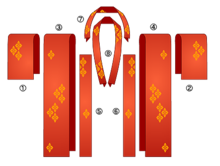
Kimono are traditionally made from a single bolt of fabric known as a tanmono, which is roughly 11.5 metres (38 ft) long and 36 centimetres (14 in) wide for women,[1] and 12.5 metres (41 ft) long and 42 centimetres (17 in) wide for men. The entire bolt is used to make one kimono, and some men's tanmono are woven to be long enough to create a matching haori jacket and juban as well. Kimono linings are made from bolts of the same width.
Some custom bolts of fabric are produced for especially tall or heavy people, such as sumo wrestlers, who must have kimono custom-made by either joining multiple bolts, weaving custom-width fabric, or using non-standard size fabric.[32] For children, in the early 1900s, shorter lengths were used, and sometimes the body of the kimono was made only a single cloth width wide (hitotsumi).[33] Tucks were also used to take in the garment; an outwards-facing pleat at each shoulder (kata-nue-age) and a kolpos-like overfold at the hip (koshi-nue-age), so that the child appeared to be wearing a sleeveless vest of the same fabric over their garment. These sewn tucks were let out as the child grew,[31]: 15 and are mostly only seen today on the kimono of apprentice geisha in Kyoto, as apprentices previously began their training at a young age, requiring tucks to be let out as they grew. In the present day, apprentices begin their training in their late teenage years, and the tucks are retained merely as an anachronism.
Though adult women also retained a 'tuck' at the hip, this was a leftover from the trailing length of most women's kimono, which had previously been either held up by hand when walking or tied up loosely with a shigoki obi; though kimono were not worn as trailing towards the end of the 19th century, the excess length of most women's kimono remained, with the hip fold formalised and neatened into the ohashori of the modern day.
Kimono have a set method of construction, which allows the entire garment to be taken apart, cleaned and resewn easily. As the seam allowance on nearly every panel features two selvedges that will not fray, the woven edges of the fabric bolt are retained when the kimono is sewn, leading to large and often uneven seam allowances; unlike Western clothing, the seam allowances are not trimmed down, allowing for a kimono to be resewn to different measurements without the fabric fraying at the seams.[citation needed] This was also used to prolong the life of the garment by reversing the sleeves (hiding the worn cuff hem in the shoulder seam) or the back panels (swapping the high-stress center seam and the low-stress sides),[34] like the European custom of side-to-middling or end-to-middling bedsheets.
Historically, kimono were taken apart entirely to be washed – a process known as arai-hari. Once cleaned, the fabric would be resewn by hand;[1] this process, though necessary in previous centuries, is uncommon in modern-day Japan, as it is relatively expensive.
Despite the expense of hand-sewing, however, some modern kimono, including silk kimono and all formal kimono, are still hand-sewn entirely; even machine-sewn kimono require some degree of hand-sewing, particularly in finishing the collar, the hem, and the lining, if present. Hand-sewn kimono are usually sewn with a single running stitch roughly 3 millimetres (0.12 in) to 4 millimetres (0.16 in) long, with stitches growing shorter around the collar area for strength. Kimono seams, instead of being pressed entirely flat, are pressed to have a 'lip' of roughly 2 millimetres (0.079 in) (known as the kise) pressed over each seam. This disguises the stitches, as hand-sewn kimono are not tightly sewn, rendering the stitches visible if pressed entirely flat.
Terms
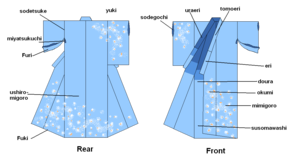
A number of terms are used to refer to the different parts of a kimono. Kimono that are lined are known as awase kimono, whereas unlined kimono are known as hitoe kimono; partially lined kimono – with lining only at the sleeve cuff, the back of the sleeve, the lower chest portion of the dōura and the entirety of the hakkake – are known as dō-bitoe (lit. 'chest-single-layer') kimono.[35] Some fully lined kimono do not have a separate lower and upper lining, and are instead lined with solid panels on the okumi, the maemigoro and the ushiromigoro.
These terms refer to parts of a kimono:
- Dōura (胴裏)
- The upper lining of a kimono.
- Hakkake (八掛)
- The lower lining of a kimono. Zdroj:https://en.wikipedia.org?pojem=Hōmongi
Text je dostupný za podmienok Creative Commons Attribution/Share-Alike License 3.0 Unported; prípadne za ďalších podmienok. Podrobnejšie informácie nájdete na stránke Podmienky použitia.
Antropológia
Aplikované vedy
Bibliometria
Dejiny vedy
Encyklopédie
Filozofia vedy
Forenzné vedy
Humanitné vedy
Knižničná veda
Kryogenika
Kryptológia
Kulturológia
Literárna veda
Medzidisciplinárne oblasti
Metódy kvantitatívnej analýzy
Metavedy
Metodika
Text je dostupný za podmienok Creative
Commons Attribution/Share-Alike License 3.0 Unported; prípadne za ďalších
podmienok.
Podrobnejšie informácie nájdete na stránke Podmienky
použitia.
www.astronomia.sk | www.biologia.sk | www.botanika.sk | www.dejiny.sk | www.economy.sk | www.elektrotechnika.sk | www.estetika.sk | www.farmakologia.sk | www.filozofia.sk | Fyzika | www.futurologia.sk | www.genetika.sk | www.chemia.sk | www.lingvistika.sk | www.politologia.sk | www.psychologia.sk | www.sexuologia.sk | www.sociologia.sk | www.veda.sk I www.zoologia.sk

